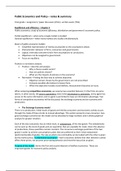Public Economics and Policy – notes & summary
Final grade = assignment / paper discussion (25%) + written exam (75%)
Equilibrium and efficiency – Chapter 2
Public economics: study of economic efficiency, distribution and government’s economic policy.
Partial equilibrium = when only a single market is studied
General equilibrium = when many markets are studies simultaneously
Basics of public economic models:
• Simplified representation of reality (as plausible as the assumptions allow).
• Characteristic: behavior of firms, consumers and governments.
• Logical, internally consistent chain from assumptions to conclusions.
• Objectives can be assigned to government.
• Focus on equilibria.
Positive vs normative analysis:
• Positive = describe and analyze
o Why is there a public sector?
o How are policies chosen?
o What are the impacts of policies on the economy?
• Normative = finding the best way to achieve objectives
o Objective remain chosen by the government; are not prescribed.
o Compare possible alternatives to laissez faire.
o When the objective includes social welfare, measurement becomes an issue.
When analyzing competitive economies, we assume two essential features; (1) the firms are price
takers, in other words, the price is parametric and (2) the information is symmetric, every agent has
access to the same information and no agent is permitted to have an information advantage. Two
forms of competitive economies will be discussed; the exchange economy and an economy with
production.
➢ The Exchange Economy model
There is no production. Initial stocks of goods are held by consumers and economic activity occurs
through the trade of these stocks to mutual advantage. This section presents a two-consumer, two-
good exchange economy but the model can be extended to large numbers and it allows graphical
analysis for greater intuition.
Each of the two consumers has an initial stock, or endowment, of the two goods. The endowments
can be seen as the stock of goods and are quantities that are available for trade. Given the absence
of productions, these quantities remain constant. The consumers exchange quantities of the two
goods in order to achieve consumptions plans that are preferred to their initial endowment
(preferred bundle of goods). The rate at which one commodity can be traded with the other is given
by the market prices. Fundamental assumption = both consumers believe that their behavior cannot
affect these prices, we assumes price-taking behavior and treat the two prices as given.
Purpose of the model: derive the first and second theorem of welfare economics. These are
important guides for economic policy analysis.
,A consumer is described by their endowments (𝜔) and their preferences. The endowment of
consumer h is denoted by 𝜔ℎ = (𝜔1ℎ , 𝜔2ℎ ), where 𝜔𝑖ℎ ≥ 0 is h’s initial stock of good i. When prices
are p1 and p2, a consumption plan for consumer h is denoted by 𝑥 ℎ = (𝑥1ℎ , 𝑥2ℎ ). The consumption
plan is affordable when it satisfies the budget constraint: 𝑝1 𝑥1ℎ + 𝑝2 𝑥2ℎ = 𝑝1 𝜔1ℎ + 𝑝2 𝜔2ℎ
The preferences of each consumer is described by their utility function. The utility function of
consumer h is denoted by 𝑈 ℎ = 𝑈 ℎ (𝑥1ℎ , 𝑥2ℎ ) and we assume the indifference curve to be convex.
This economy can be pictured in a diagram that allows the role of prices in achieving equilibrium to
be explored. The diagram is constructed by noting that the total consumption of the two consumers
must be equal to the available stock of the two goods, where the stock is determined by the
endowments. Any pair of consumption plans that satisfies these requirement is called a
feasible plan for the economy: 𝑥𝑖1 + 𝑥𝑖2 = 𝜔1𝑖 + 𝜔𝑖2
The diagram used for this economy is called an Edgeworth box.
From the diagram it can be seen that the budget constraint for both consumers must pass through
the endowment point, since consumers can always afford their endowment. The endowment point
is common for both consumers, so a single budget line through the endowment point captures the
𝑝1
marker opportunities for both consumers. Given the budget line (slope = − 𝑝2), the utility-
maximizing choices for the two consumers are characterized by the standard tangency condition
between the highest attainable indifference curve and the budget line.
,The consumer choices shown in figure 2.2 do not constitute an equilibrium for the economy. That
can be seen by summing the demands and comparing these to the level of the endowments. Doing
this shows that the demand for good 1 exceeds the endowment but the demand for good 2 falls
short. To achieve an equilibrium position, the relative prices of the goods must change. An increase
of the price of good 1 makes the budge line steeper (still passing through the endowment point).
The effect of a relative price change in good 1 is shown in figure 2.3. The consumers now select their
consumption plans based on a new budget constraint and reach an equilibrium.
The dependence of the consumption levels on prices is summarized in the consumers’ demand
functions: 𝑥𝑖ℎ = 𝑥𝑖ℎ (𝑝1, 𝑝2). Using the demand functions, we see that demand is equal to supply for
the economy when the prices are such that 𝑥𝑖1 (𝑝1, 𝑝2) + 𝑥𝑖2 (𝑝1, 𝑝2) = 𝜔1𝑖 + 𝜔𝑖2
The Edgeworth box shows that such an equilibrium is achieved when the prices lead to a budget line
on which the indifference curves of the consumers have a point of common tangency.
In order to analyze the model, the indeterminacy of the level of prices needs to be removed. This is
achieved by adopting a price normalization, which is simply a method of fixing a scale for prices. The
simples way to do this is to select a commodity as numéraire, which means that its price is fixed at
one, and measure all other prices relative to this. The numéraire chosen in this way can be thought
of as the unit of account for the economy.
➢ The Production & Exchange Economy model
An economy with production consists of consumers and producers. The firms use inputs to produce
outputs with the intention to maximize profits. The consumers have preferences and initial
endowments as they did in the exchanged economy, but they now also hold shares in the firms. The
firms’ profits are distributed as dividends in proportion to the shareholdings. The consumers receive
income from the sale of their initial endowments (their labor time) and from their dividend
payments.
• A negative quantity means that a good is used as input (good 1)
• A negative quantity means that a good is used as output (good 2)
Thus, the production possibility frontier (the outer contour of the production set) shows how much
of good 2 can be produced using good 1 as input (figure 2.6).
, Each firm is characterized by its production set,
which summarizes the production technology it has
available. For firm j operating in an economy with
two goods a typical production set is denoted as 𝑦 𝑗 .
Consider the firm shown in figure 2.6 choosing a
production plan will lead to the following equation
𝑗 𝑗
for the firm’s profit: 𝜋 𝑗 = 𝑝1 𝑦1 + 𝑝2 𝑦2 The
positive part can be seen as the sales revenue and
the negative part as the production cost.
The process of profit maximization is illustrated in figure 2.7. Because p1 and p2 are given, these
prices are used to construct the isoprofit curves:
- Shows all production plans that yield the same level of profit.
- The one through origin is always zero-profit.
- The slope is calculated in the same way as the budget constraint: - p1/p2
- A higher isoprofit line implies a higher profit.
The profit-maximizing firm will choose a production plan that places it upon the highest attainable
isoprofit curve (y*). Point y* is located at the tangency point between the highest attainable
isoprofit curve and the production set. There is no other feasible plan that can attain higher profit.
Efficiency of competition
In case of an individual decision-maker the efficient outcome has been achieved when the utility is
maximized given the resources and production set available. Problems arise when there is more
than one decision-maker, it requires efficiency to be defined with respect to a set of aggregate
preferences. We now resolve this by relying on Pareto efficiency where no player can be better off
without making someone else worse off.





